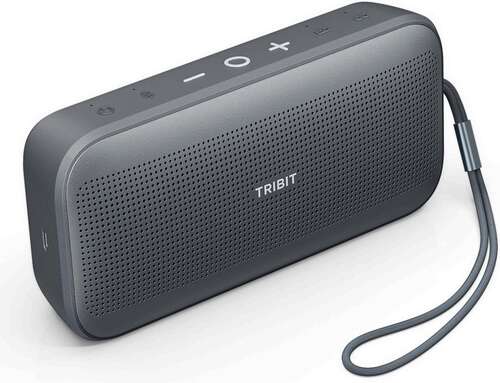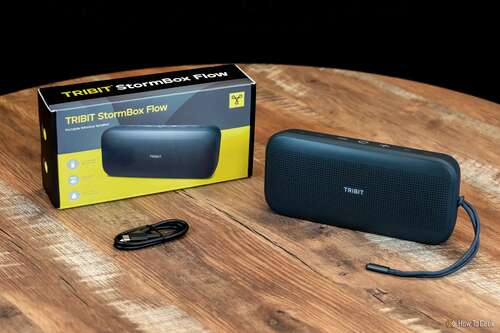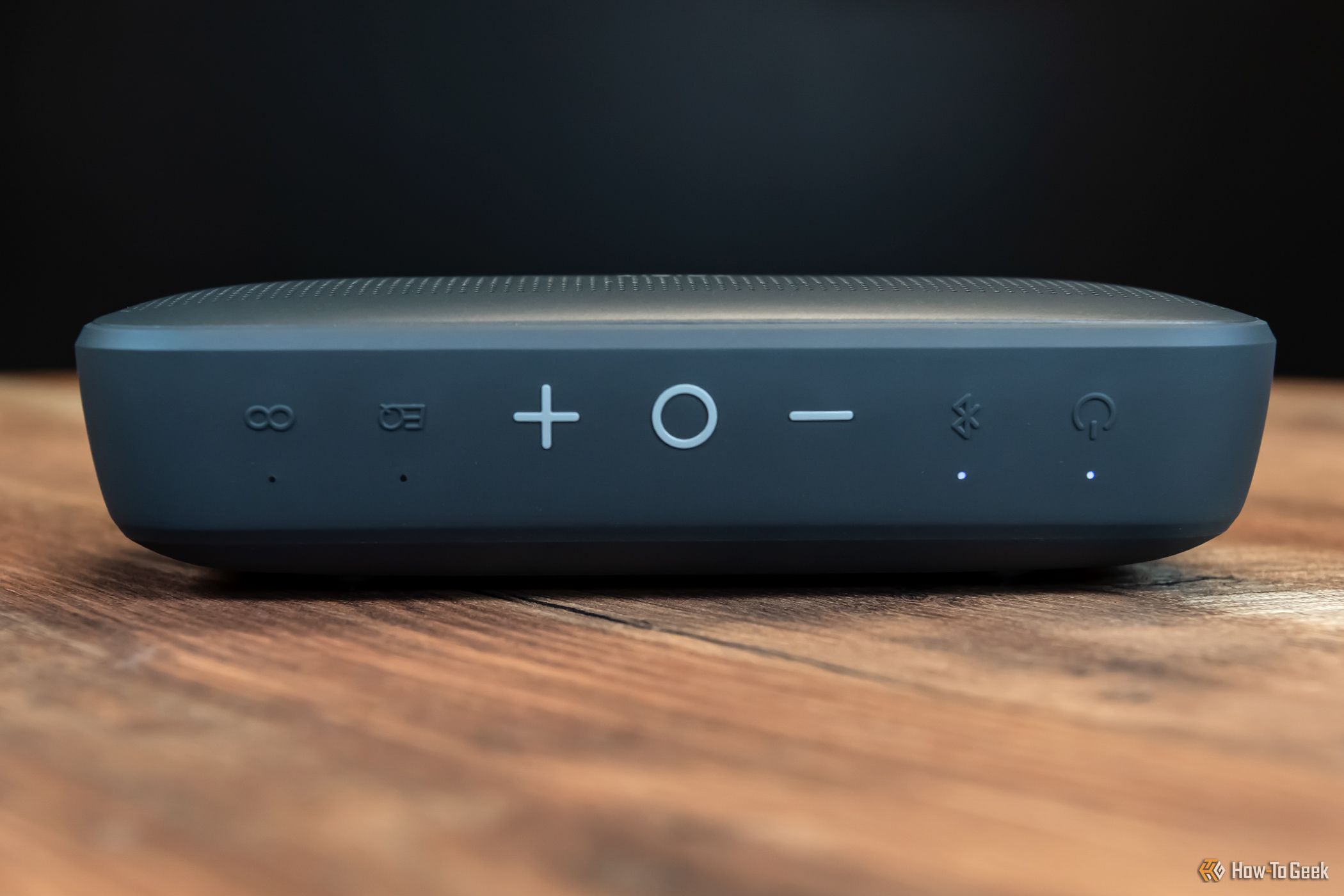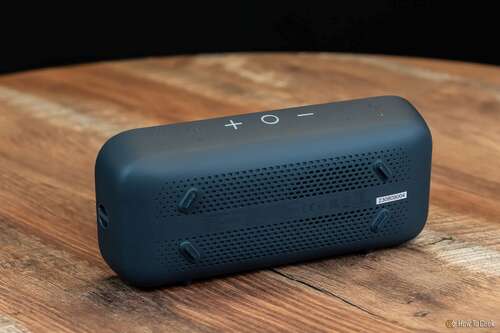Key Takeaways
- StormBox Flow offers solid sound paired with XBass boosting technology at a reasonable price point.
- XBass mode improves audio quality across various music genres and will probably used for all music listening.
- Tribit app allows customization of EQ presets, but is basic compared to other speaker apps.
Compact portable Bluetooth speakers are nearly a commodity these days, but the question is which one should you buy? One of the latest entries is the Tribit StormBox Flow which directly competes against the Sonos Roam and Bose SoundLink Flex. It’s a worthy sound competitor at a lower price but it won’t get you the same ecosystem benefits as the other options.

Tribit StormBox Flow
Indulge in the StormBox Flow outdoor speaker audio experience with distinct vocals and powerful bass like no other. Tribit’s proprietary XBass tuning DSP technology boosts bass by 9dB at the same power playback.
- Maximum output power
- 25W
- Connectivity
- Bluetooth 5.3
- Weight
- 1.45lbs (660g)
- Dimensions
- 7.91 x 3.5 x 2.06in (201 x 90.4 x 52.4mm)
- Frequency
- 50~20KHz
- Water and dust resistance
- IP67
- Decent, full sound with XBass on
- Long battery life
- Small enough to carry around
- Bulkier and heavier than Bose?s speaker
- No mic for calls
- Without XBass EQ the speaker can sound flat
The Design Is Not Trying to Break the Mold
Although the Tribit StormBox Flow is in the same realm as the Sonos Roam, it rips off the design of the Bose SoundLink Flex. It wants to replace that speaker Bose released in 2021—even the Flex and Flow names are similar. To that end, it does outdo the competition in several areas, but not all of them.
Tribit’s speaker provides 30 hours of battery life, with volume at 60% and XBass off, or 24 hours with XBass turned on. It uses a Bluetooth 5.3 connection as well. Both speakers feature a dust and water resistance IP67 rating and can be used standing up or lying on their backs.
The Bose SoundLink Flex prioritizes portability by being smaller and lighter. Even though the Tribit StormBox Flow can be carried in hand and isn’t hard to move from one room to another, it’s still noticeable in a backpack. It’s just slightly chunkier and heavier than I would have preferred.
You Can Get Solid Sound From This Handheld Speaker
The StormBox Flow follows in the steps of a lot of other budget-friendly Bluetooth speakers. That is, it sounds more impressive than you would think, but it still has some rough edges, either in how far it can push a top volume or the style of music that works best through its drivers.
With the Flow, the fringe of its sound comes in its default, basic sound EQ. When you open the box, turn it on, and connect it to your phone, songs tend to sound a little hollow and flat. That changes enough with the XBass mode turned on that it becomes a non-issue.
Basically, you’ll pretty much always want to leave the XBass mode turned on, whenever listening to pop, rock, hip-hop, or most other genres of music. Across a wide selection of songs, I didn’t find one that I thought sounded bad at a 30 to 40% volume level with XBass on.
That EQ mode should probably have been the default, but luckily it does stay enabled each time the device is used, through power-offs, until you cycle to a different EQ setting.
If you’re not listening to music, I found the audiobook EQ pre-set to be good for spoken content like radio broadcasts, podcasts, and audiobooks. The mode strips a lot of the bass out and boosts the mid-range where vocals reside to make people speaking easier to hear. It’s the other end of the spectrum from XBass.
The Tribit App Is Basic
The way to control the different EQ modes is to press the EQ button on the Flow speaker. Out of the box, this button will cycle through XBass, audiobook, and no EQ preset. Inside the Tribit app—available for iPhone or Android—you can customize the three slots with any EQ setting.
You can change what the EQ is for no light, white light, and blue light. In this case, you can kinda make the Xbass the default by changing to the setting for no light, but then again, since it remembers the EQ setting after shutdown means that no button setting is more special than another one. Unfortunately, you can’t set the same EQ choice for more than one light. Beyond customizing the EQ button, the Tribit app is basic and I never found myself opening it.
Price and Availability
The Tribit StormBoxFlow retails for $79.99. It’s flanked by other Tribit speakers like the StormBox Pro which retails for $119.99 and the lower-end MaxSound Plus for $59.99.
Should You Buy Tribit StormBox Flow?
Overall, I’ve been impressed with Tribit’s price-conscious Bluetooth speakers over the years and the latest StormBox Flow one is no different. It performs well for its size and feature set. That means it gets loud enough with a decent sound and enough battery life. I didn’t continually have to worry about it being dead after a day or two of listening.
As good of a value as the speaker is, however, it isn’t the best in its class. If you want a smaller option that has a microphone to take calls on, the Bose SoundFlex is still a great choice. If you want a speaker that can hang on your Wi-Fi network, instead of being relegated to Bluetooth, then the Sonos Roam is solid.

Tribit StormBox Flow
Indulge in the StormBox Flow outdoor speaker audio experience with distinct vocals and powerful bass like no other. Tribit’s proprietary XBass tuning DSP technology boosts bass by 9dB at the same power playback.




